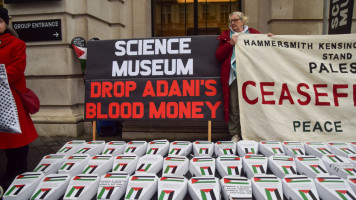How international diplomacy failed Palestinian refugees after the 1948 Nakba
Palestinian Refugees After 1948: The Failure of International Diplomacy (I.B. Tauris, 2022) focuses on the period commencing with the 1948 Nakba until 1968 – a year following the Six-Day War when Palestine became militarily occupied by Israel.
In this accessible detailing of political events which failed to provide a solution for Palestinian refugees, author Marte Heian-Engdal identifies four key factors that contributed to the ongoing violation of forced displacement: Israel’s international diplomacy, US administrations’ concerns with domestic political gains over international strategy, timing in international relations, and the absence of will on behalf of both Israel and Arab states to reach an agreement.
"What stands out in Heian-Engdal’s book is the absolute marginalisation of the Palestinian people from their own forced displacement and the politics of return, even with regard to Arab states, who prioritised their agreements with Israel over a solution that would prioritise repatriation"
The author notes that since the 1947 Partition Plan, Palestinians were less politically prepared for statehood than the Zionist camp.
While the 1948 Nakba generated the first large wave of dispossessed Palestinians, the refusal to allow Palestinians to return marked the reality of Palestinian refugees and the need for a solution, which Swedish diplomat Count Folke Bernadotte, who was murdered by Zionist paramilitary gangs a day after submitting his report to the UN in September 1948, called for.
His recommendation to settle the Palestinian refugee issue became the foundation for UN Resolution 194, which deals with the Palestinian right of return.
|
While the book itself does not indicate any new research – the author herself makes the admission in the beginning – the narration of diplomatic events is engaging and makes for accessible reading.
Much of the book deals with the prominent role the US played in terms of diplomacy and how US administrations thwarted the right of return through diplomatic engagement with Israel that diminished the prospects of plans that might have held political substance for Palestinians.
However, what stands out from the narration is the symbolism attached to the Palestinian right of return. The politics of making a symbolic gesture to Palestinians which would not irk Israel was of paramount importance to US administrations and harmful to Palestinians, whose political rights degenerated into a humanitarian paradigm that continues to date.
Meanwhile, Israel’s colonisation plans were of paramount importance, which pushed the Palestinian refugee issue to the sidelines, while making conciliatory gestures to keep the international community waiting. “The Israeli leadership thought it better to wait a few years and elude some of the outside pressure that was then being applied to finding a solution to the refugee issue.”
One move Israel played and to which the US acquiesced was Chaim Weizmann telling US President Harry Truman that once Israel became a UN member state, negotiating on the Palestinian refugee issue would be easier. In 1949, Israel offered to repatriate 100,000 refugees, less than the 250,000 the US had proposed. The failure to move beyond the impasse resulted in the creation of the United Nations Relief and Works Agency for Palestine Refugees (UNRWA).
Meanwhile, the Johnson Plan, which advocated for compensation for all Palestinian refugees was met with opposition from the US State Department, which insisted on either repatriation or compensation.
While the US still diplomatically approached the Palestinian refugee issue from the UN framework, the proposal of a referendum for Palestinian refugees on resettlement, repatriation and compensation was met with opposition by the then Israeli Prime Minister David Ben Gurion, who described the plan as “designed to destroy Israel.”
|
Heian-Engdal notes that the Kennedy administration was only focused on repatriation and resettlement, a nod to both Israel and the Jewish voters in the US, 83 percent of whom had voted for Kennedy in the presidential elections.
Additionally, the author states, Kennedy is seen as the president who “had done more to satisfy Israeli security preoccupations than any of its predecessors.” Within the same period of the Kennedy administration, Israel sought many reassurances from the US, including asking the US to use the veto and to prevent any Arab resolutions brought forward to the UN.
Another important point the author makes is how the Arab states viewed US President John F. Kennedy as more pro-Israeli, following the failed US Bay of Pigs invasion of Cuba.
Heian-Engdal notes that the emergence of the Palestine Liberation Organisation at the Arab Summit in Cairo in 1964 was also a means to restrain the Palestinian resistance movement. With the 1967 war increasing Palestinian refugees by another 320,000, “the international community’s diplomatic focus would be on territories, not people.”
What stands out in Heian-Engdal’s book is the absolute marginalisation of the Palestinian people from their own forced displacement and the politics of return, even with regard to Arab states, who prioritised their agreements with Israel over a solution that would prioritise repatriation.
Reading this book, the realisation that Palestinians require spaces to articulate their political demands resonates more than ever. It is this understanding that the book brings to light – the loss of a land and people who never had the chance to speak for themselves.
Ramona Wadi is an independent researcher, freelance journalist, book reviewer and blogger specialising in the struggle for memory in Chile and Palestine, colonial violence and the manipulation of international law.



